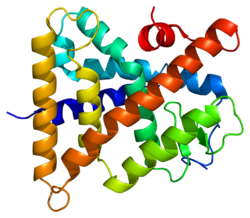Hepatocyte nuclear factor 4 gamma (HNF4G) also known as NR2A2 (nuclear receptor subfamily 2, group A, member 2) is a nuclear receptor that in humans is encoded by the HNF4G gene.
Function
HNF4G is a transcription factor that has been shown to play a significant role in intestinal epithelial cell differentiation and function. Research using integrative multi-omics analysis of intestinal organoid differentiation has revealed that HNF4G acts as a master regulator of gene regulation in differentiation towards the enterocyte lineage. The study demonstrated widespread binding to promoters and enhancers that are activated in enterocytes, and that the loss of Hnf4g results in a partial loss of enterocyte differentiation, indicating its importance in maintaining the enterocyte lineage.
See also
References
- ^ GRCh38: Ensembl release 89: ENSG00000164749 – Ensembl, May 2017
- ^ GRCm38: Ensembl release 89: ENSMUSG00000017688 – Ensembl, May 2017
- "Human PubMed Reference:". National Center for Biotechnology Information, U.S. National Library of Medicine.
- "Mouse PubMed Reference:". National Center for Biotechnology Information, U.S. National Library of Medicine.
- "Entrez Gene: HNF4G hepatocyte nuclear factor 4, gamma".
- Drewes T, Senkel S, Holewa B, Ryffel GU (March 1996). "Human hepatocyte nuclear factor 4 isoforms are encoded by distinct and differentially expressed genes". Molecular and Cellular Biology. 16 (3): 925–931. doi:10.1128/mcb.16.3.925. PMC 231074. PMID 8622695.
- Wisely GB, Miller AB, Davis RG, Thornquest AD, Johnson R, Spitzer T, et al. (September 2002). "Hepatocyte nuclear factor 4 is a transcription factor that constitutively binds fatty acids". Structure. 10 (9): 1225–1234. doi:10.1016/S0969-2126(02)00829-8. PMID 12220494.
- Lindeboom RG, van Voorthuijsen L, Oost KC, Rodríguez-Colman MJ, Luna-Velez MV, Furlan C, et al. (June 2018). "Integrative multi-omics analysis of intestinal organoid differentiation". Molecular Systems Biology. 14 (6): e8227. doi:10.15252/msb.20188227. PMC 6018986. PMID 29945941.
Further reading
- Plengvidhya N, Antonellis A, Wogan LT, Poleev A, Borgschulze M, Warram JH, et al. (October 1999). "Hepatocyte nuclear factor-4gamma: cDNA sequence, gene organization, and mutation screening in early-onset autosomal-dominant type 2 diabetes". Diabetes. 48 (10): 2099–2102. doi:10.2337/diabetes.48.10.2099. PMID 10512380.
- Ozeki T, Takahashi Y, Nakayama K, Funayama M, Nagashima K, Kodama T, et al. (January 2003). "Hepatocyte nuclear factor-4 alpha/gamma and hepatocyte nuclear factor-1 alpha as causal factors of interindividual difference in the expression of human dihydrodiol dehydrogenase 4 mRNA in human livers". Pharmacogenetics. 13 (1): 49–53. doi:10.1097/00008571-200301000-00007. PMID 12544512.
External links
| PDB gallery | |
|---|---|
| Transcription factors and intracellular receptors | |||||||||||||||||||||||||||||||
|---|---|---|---|---|---|---|---|---|---|---|---|---|---|---|---|---|---|---|---|---|---|---|---|---|---|---|---|---|---|---|---|
| |||||||||||||||||||||||||||||||
| |||||||||||||||||||||||||||||||
| |||||||||||||||||||||||||||||||
| |||||||||||||||||||||||||||||||
| |||||||||||||||||||||||||||||||
| see also transcription factor/coregulator deficiencies | |||||||||||||||||||||||||||||||
This article on a gene on human chromosome 8 is a stub. You can help Misplaced Pages by expanding it. |






